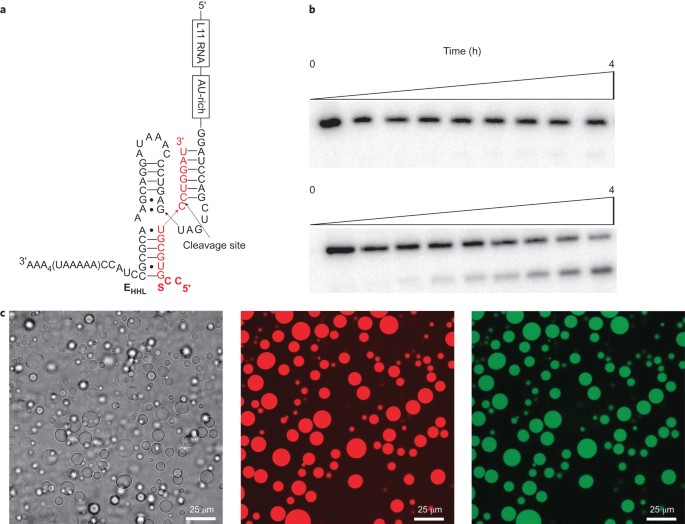
- Select a language for the TTS:
- UK English Female
- UK English Male
- US English Female
- US English Male
- Australian Female
- Australian Male
- Language selected: (auto detect) - EN
Play all audios:
ABSTRACT RNA performs important cellular functions in contemporary life forms. Its ability to act both as a catalyst and a storage mechanism for genetic information is also an important part
of the RNA world hypothesis. Compartmentalization within modern cells allows the local concentration of RNA to be controlled and it has been suggested that this was also important in early
life forms. Here, we mimic intracellular compartmentalization and macromolecular crowding by partitioning RNA in an aqueous two-phase system (ATPS). We show that the concentration of RNA is
enriched by up to 3,000-fold in the dextran-rich phase of a polyethylene glycol/dextran ATPS and demonstrate that this can lead to approximately 70-fold increase in the rate of ribozyme
cleavage. This rate enhancement can be tuned by the relative volumes of the two phases in the ATPS. Our observations support the importance of compartmentalization in the attainment of
function in an RNA World as well as in modern biology. Access through your institution Buy or subscribe This is a preview of subscription content, access via your institution ACCESS OPTIONS
Access through your institution Subscribe to this journal Receive 12 print issues and online access $259.00 per year only $21.58 per issue Learn more Buy this article * Purchase on
SpringerLink * Instant access to full article PDF Buy now Prices may be subject to local taxes which are calculated during checkout ADDITIONAL ACCESS OPTIONS: * Log in * Learn about
institutional subscriptions * Read our FAQs * Contact customer support SIMILAR CONTENT BEING VIEWED BY OTHERS BIOMOLECULAR CONDENSATES – EXTANT RELICS OR EVOLVING MICROCOMPARTMENTS? Article
Open access 21 June 2023 MODULAR RNA MOTIFS FOR ORTHOGONAL PHASE SEPARATED COMPARTMENTS Article Open access 30 July 2024 RNA CONTRIBUTIONS TO THE FORM AND FUNCTION OF BIOMOLECULAR
CONDENSATES Article 06 July 2020 REFERENCES * Deeds, E. J., Ashenberg, O., Gerardin, J. & Shakhnovich, E. I. Robust protein–protein interactions in crowded cellular environments. _Proc.
Natl Acad. Sci. USA_ 104, 14952–14957 (2007). Article CAS Google Scholar * Matera, G. & Shpargel, K. Pumping RNA. Nuclear bodybuilding along the RNA pipeline. _Curr. Opin. Cell Biol._
18, 317–324 (2006). Article CAS Google Scholar * Atkins, J. F., Gesteland, R. F. & Cech, T. R. _RNA Worlds: From Life's Origins to Diversity in Gene Regulation_ (Cold Spring
Harbor Press, 2010). Google Scholar * Albertsson, P. Å. _Partition of Cell Particles and Macromolecules_ (Wiley, 1960). Google Scholar * Zaslavsky, B. Y. _Aqueous Two-Phase Partitioning:
Physical Chemistry and Bioanalytical Applications_ (Marcel Dekker, 1995). Google Scholar * Hatti-Kaul, R. _Aqueous Two-Phase Systems: Methods and Protocols_ (Humana Press, 2000). Book
Google Scholar * Albertsson, P. Å . & Tjerneld, F. Phase diagrams. _Methods Enzymol._ 228, 3–13 (1994). Article CAS Google Scholar * Ellis, R. J. Macromolecular crowding: obvious but
underappreciated. _Trends Biochem. Sci._ 26, 597–604 (2001). Article CAS Google Scholar * Zhou, H. X., Rivas, G. & Minton, A. P. Macromolecular crowding and confinement: biochemical,
biophysical, and potential physiological consequences. _Annu. Rev. Biophys._ 37, 375–397 (2008). Article CAS Google Scholar * Long, M. S., Jones, C. D., Helfrich, M. R., Mangeney-Slavin,
L. K. & Keating, C. D. Dynamic microcompartmentation in synthetic cells. _Proc. Natl Acad. Sci. USA_ 102, 5920–5925 (2005). Article CAS Google Scholar * Diamond, A. D. & Hsu, J.
T. Fundamental studies of biomolecule partitioning in aqueous two-phase systems. _Biotechnol. Bioeng._ 34, 1000–1014 (1989). Article CAS Google Scholar * Stage-Zimmermann, T. K. &
Uhlenbeck, O. C. Hammerhead ribozyme kinetics. _RNA_ 4, 875–889 (1998). Article CAS Google Scholar * Scott, W. G., Finch, J. T. & Klug, A. The crystal structure of an all-RNA
hammerhead ribozyme: a proposed mechanism for RNA catalytic cleavage. _Cell_ 81, 991–1002 (1995). Article CAS Google Scholar * Martick, M. & Scott, W. G. Tertiary contacts distant
from the active site prime a ribozyme for catalysis. _Cell_ 126, 309–320 (2006). Article CAS Google Scholar * Khvorova, A., Lescoute, A., Westhof, E. & Jayasena, S. D. Sequence
elements outside the hammerhead ribozyme catalytic core enable intracellular activity. _Nature Struct. Mol. Biol._ 10, 708–712 (2003). Article CAS Google Scholar * Lambert, D., Heckman,
J. E. & Burke, J. M. Three conserved guanosines approach the reaction site in native and minimal hammerhead ribozymes. _Biochemistry_ 45, 7140–7147 (2006). Article CAS Google Scholar
* Osborne, E. M., Schaak, J. E. & Derose, V. J. Characterization of a native hammerhead ribozyme derived from schistosomes. _RNA_ 11, 187–196 (2005). Article CAS Google Scholar *
Laing, L. G. & Draper, D. E. Thermodynamics of RNA folding in a conserved ribosomal RNA domain. _J. Mol. Biol._ 237, 560–576 (1994). Article CAS Google Scholar * Hertel, K. J.,
Herschlag, D. & Uhlenbeck, O. C. A kinetic and thermodynamic framework for the hammerhead ribozyme reaction. _Biochemistry_ 33, 3374–3385 (1994). Article CAS Google Scholar * Hertel,
K. J., Hershclag, D. & Uhlenbeck, O. C. Specificity of hammerhead ribozyme cleavage. _EMBO J._ 15, 3751–3757 (1996). Article CAS Google Scholar * Long, M. S. & Keating, C. D.
Nanoparticle conjugation increases protein partitioning in aqueous two-phase systems. _Anal. Chem._ 78, 379–386 (2006). Article CAS Google Scholar * Alberts, B., Bray, D., Lewis, J.,
Raff, M., Roberts, K. & Watson, J. D. _Molecular Biology of the Cell_ 3rd edn (Garland Publishing, 1994). Google Scholar * Feig, A. L. & Uhlenbeck, O. _The Role of Metal Ions in RNA
Biochemistry. In The RNA World_ (Cold Spring Harbor Press, 1999). Google Scholar * Herschlag, D. & Cech, T. R. Catalysis of RNA cleavage by the _Tetrahymena thermophila_ ribozyme.
_Biochemistry_ 29, 10172–10180 (1990). Article CAS Google Scholar * Nakano, S., Karimata, H. T., Kitagawa, Y. & Sugimoto, N. Facilitation of RNA enzyme activity in the molecular
crowding media of cosolutes. _J. Am. Chem. Soc._ 131, 16881–16888 (2009). Article CAS Google Scholar * Keighron, J. D. & Keating, C. D. _Towards a Minimal Cytoplasm. In The Minimal
Cell_ (Springer, 2011). Google Scholar * Brennecke, J., Stark, A., Russell, R. B. & Cohen, S. M. Principles of microRNA-target recognition. _PLoS Biol._ 3, e85 (2005). Article Google
Scholar * Joyce, G. F. Molecular evolution: booting up life. _Nature_ 420, 278–279 (2002). Article CAS Google Scholar * Jencks, W. P. _Catalysis in Chemistry and Enzymology_ (Dover,
1969). Google Scholar * Levy, M., Griswold, K. E. & Ellington, A. D. Direct selection of trans-acting ligase ribozymes by _in vitro_ compartmentalization. _RNA_ 11, 1555–1562 (2005).
Article CAS Google Scholar * Ghadessy, F. J., Ong, J. L. & Holliger, P. Directed evolution of polymerase function by compartmentalized self-replication. _Proc. Natl Acad. Sci. USA_
98, 4552–4557 (2001). Article CAS Google Scholar * Griffiths, A. D. & Tawfik, D. S. Directed evolution of an extremely fast phosphotriesterase by _in vitro_ compartmentalization.
_EMBO J._ 22, 24–35 (2003). Article CAS Google Scholar * Brengues, M., Teixeira, D. & Parker, R. Movement of eukaryotic mRNAs between polysomes and cytoplasmic processing bodies.
_Science_ 310, 486–489 (2005). Article CAS Google Scholar * Brangwynne, C. P. et al. Germline P granules are liquid droplets that localize by controlled dissolution/condensation.
_Science_ 324, 1729–1732 (2009). Article CAS Google Scholar * Lamond, A. I. & Spector, D. L. Nuclear speckles: a model for nuclear organelles. _Nature Rev. Mol. Cell Biol._ 4, 605–612
(2003). Article CAS Google Scholar * Lewis, J. D. & Tollervey, D. Like attracts like: getting RNA processing together in the nucleus. _Science_ 288, 1385–1389 (2000). Article CAS
Google Scholar * Brangwynne, C. P. Soft active aggregates:mechanics, dynamics and self-assembly of liquid-like intracellular protein bodies. _Soft Matter_ 7, 3052–3059 (2011). Article CAS
Google Scholar * Chubb, J. R. & Bickmore, W. A. Considering nuclear compartmentalization in the light of nuclear dynamics. _Cell_ 112, 403–406 (2003). Article CAS Google Scholar *
Hancock, R. A role for macromolecular crowding effects in the assembly and function of compartments in the nucleus. _J. Struct. Biol._ 146, 281–290 (2004). Article CAS Google Scholar *
Brangwynne, C. P., Mitchison, T. J. & Hyman, A. A. Active liquid-like behavior of nucleoli determines their size and shape in _Xenopus laevis_ oocytes. _Proc. Natl Acad. Sci. USA_ 108,
4334–4339 (2011). Article CAS Google Scholar * Woese, C. R. On the evolution of the genetic code. _Proc. Natl Acad. Sci. USA_ 54, 1546–1552 (1965). Article CAS Google Scholar * Orgel,
L. E. Evolution of the genetic apparatus. _J. Mol. Biol._ 38, 381–393 (1968). Article CAS Google Scholar * Crick, F. C. The origin of the genetic code. _J. Mol. Biol._ 38, 367–379 (1968).
Article CAS Google Scholar * Szostak, J. W., Bartel, D. P. & Luisi, P. L. Synthesizing life. _Nature_ 409, 387–390 (2001). Article CAS Google Scholar * Keating, C. D. Aqueous
phase separation as a possible route to compartmentalization of biological molecules. _Acc. Chem. Res._ http://dx.doi.org/10.1021/ar200294y. * Koga, S., Williams, D. S., Perriman, A. W.
& Mann, S. Peptide-nucleotide microdroplets as a step towards a membrane-free protocell model. _Nature Chem._ 3, 720–724 (2011). Article CAS Google Scholar * Oparin, A. I.,
Serebrovskaya, K. B. & Auerman, T. L. Synthesizing action of polynucleotidephosphorylase of _Micrococcus lysodeikticus_ in solution and in coacervate systems. _Biokhimiya_ 26, 499–504
(1961). CAS Google Scholar Download references ACKNOWLEDGEMENTS This work was supported by the National Science Foundation (grant CHE-0750196), co-funded by the MCB division. The authors
thank members of the Bevilacqua and Keating laboratories for helpful comments on the manuscript. The authors also thank D. Dewey and M. Andes-Koback for help with fluorescence microscopy.
AUTHOR INFORMATION Author notes * Rosalynn C. Molden Present address: Present Address: Department of Chemistry, Princeton University, Princeton, New Jersey 08544, USA, AUTHORS AND
AFFILIATIONS * Department of Chemistry, The Pennsylvania State University, University Park, Pennsylvania, 16802, USA Christopher A. Strulson, Rosalynn C. Molden, Christine D. Keating &
Philip C. Bevilacqua * Center for RNA Molecular Biology, The Pennsylvania State University, University Park, Pennsylvania, 16802, USA Christopher A. Strulson & Philip C. Bevilacqua
Authors * Christopher A. Strulson View author publications You can also search for this author inPubMed Google Scholar * Rosalynn C. Molden View author publications You can also search for
this author inPubMed Google Scholar * Christine D. Keating View author publications You can also search for this author inPubMed Google Scholar * Philip C. Bevilacqua View author
publications You can also search for this author inPubMed Google Scholar CONTRIBUTIONS C.A.S. and R.C.M. performed the experiments. All authors contributed ideas, discussed the results, and
wrote the manuscript. CORRESPONDING AUTHORS Correspondence to Christine D. Keating or Philip C. Bevilacqua. ETHICS DECLARATIONS COMPETING INTERESTS The authors declare no competing financial
interests. SUPPLEMENTARY INFORMATION SUPPLEMENTARY INFORMATION Supplementary information (PDF 1487 kb) RIGHTS AND PERMISSIONS Reprints and permissions ABOUT THIS ARTICLE CITE THIS ARTICLE
Strulson, C., Molden, R., Keating, C. _et al._ RNA catalysis through compartmentalization. _Nature Chem_ 4, 941–946 (2012). https://doi.org/10.1038/nchem.1466 Download citation * Received:
29 March 2012 * Accepted: 23 August 2012 * Published: 14 October 2012 * Issue Date: November 2012 * DOI: https://doi.org/10.1038/nchem.1466 SHARE THIS ARTICLE Anyone you share the following
link with will be able to read this content: Get shareable link Sorry, a shareable link is not currently available for this article. Copy to clipboard Provided by the Springer Nature
SharedIt content-sharing initiative
:max_bytes(150000):strip_icc():focal(216x0:218x2)/benedict-cumberbatch-1-435-4-20cc736017b24435a3498a49d7c22b0e.jpg)





